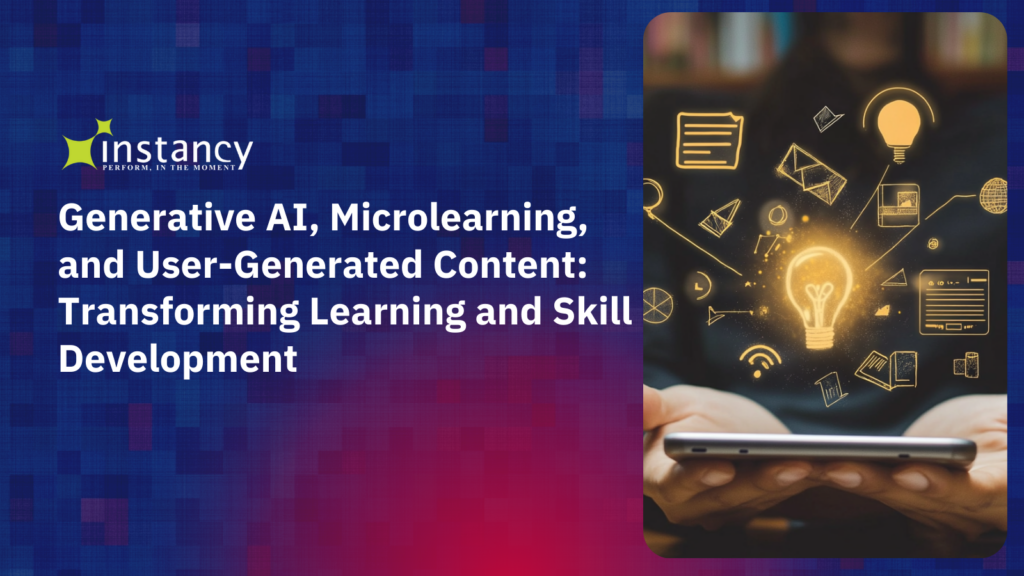Introduction
In today’s fast-paced digital world, microlearning and User-Generated Content (UGC) are revolutionizing education and corporate training. Traditional learning models, often rigid and time-consuming, no longer meet the needs of modern learners who crave flexibility, engagement, and practical knowledge. Microlearning, which delivers content in short, focused bursts, caters to these preferences, ensuring higher retention and immediate applicability. Meanwhile, UGC empowers learners and subject matter experts (SMEs) to create and share content, fostering a participatory learning ecosystem.
At the core of this transformation is Generative AI—a technology that enables SMEs to seamlessly convert their expertise into dynamic, personalized, and scalable learning experiences. The synergy between microlearning, UGC, and Generative AI represents more than just an emerging trend; it is a fundamental shift in the way learning and professional development are structured in a digital-first world.
Understanding User-Generated Content (UGC) in Learning
User-Generated Content (UGC) is any form of content—videos, assessments, tutorials, discussion threads, collaborative documents, and microlearning modules—created by users rather than centralized institutions or professional developers. In the realm of education and skill development, UGC transforms passive learning into an interactive and collaborative experience.
In corporate environments, for instance, employees can generate training materials based on their experiences, ensuring that learning content remains highly relevant, practical, and continually updated. This participatory model enhances engagement and allows for a more organic exchange of knowledge.
Why Microlearning and UGC Matter in Modern Learning
The shift towards on-demand, flexible learning models is driven by several factors:
The Power of Microlearning
- Enhanced Retention: Short, focused lessons reduce cognitive overload and make it easier for learners to absorb and apply knowledge.
- On-the-Go Accessibility: Employees and students can access bite-sized content anytime, anywhere.
- Faster Skill Application: Learners can immediately implement what they learn in real-world scenarios.
The Advantages of UGC
- Increased Engagement: Learning from peers often resonates more than content produced by formal institutions.
- Diverse Perspectives: UGC integrates multiple viewpoints, leading to a richer learning experience.
- Empowerment and Community Building: Learners become contributors, fostering deeper engagement and ownership of the learning process.
- Cost Efficiency: Organizations save resources by leveraging internal expertise for training materials.
- Knowledge Continuity: Companies can capture and retain the expertise of experienced employees, ensuring that critical knowledge is preserved.
By combining the efficiency of microlearning with the participatory nature of UGC, organizations can create dynamic learning ecosystems where learners are both consumers and contributors.
Generative AI’s Role in Scaling Microlearning and UGC
Generative AI is transforming how microlearning and UGC are developed, making it easier than ever for SMEs to convert their knowledge into structured learning content. AI-driven tools streamline the process of content creation, curation, personalization, and assessment, enabling organizations to scale learning initiatives efficiently.
1. AI-Powered Content Creation
Generative AI automates the creation of eLearning modules, quizzes, presentations, videos, and interactive experiences. SMEs can input their expertise, and AI handles structuring, formatting, and even multimedia generation—saving time and effort.
2. Personalized Learning at Scale
AI-driven platforms analyze learner behavior, preferences, and progress, dynamically adapting content to individual needs. Adaptive learning ensures that users receive content at the right difficulty level, reinforcing understanding while minimizing frustration.
3. Democratizing Knowledge Sharing
AI makes high-quality learning accessible across geographic, linguistic, and industry-specific barriers. By automating content translation, summarization, and adaptation, organizations can provide globally scalable training solutions.
4. Instant Feedback and Assessment
AI-powered assessments provide immediate feedback, guiding learners toward improvement areas. Automated grading, natural language processing (NLP) for essay evaluation, and interactive knowledge checks streamline the assessment process.
Real-World Example: AI-Driven Learning Platforms
Innovative platforms, such as Instancy’s Learning Experience Platform, demonstrate how Generative AI can facilitate the creation and delivery of microlearning and UGC. These platforms allow:
- SMEs and learners to generate AI-powered chatbots that answer training-related questions.
- Quick development of multimedia-based microlearning modules.
- Integration of conversational AI interfaces for personalized learning assistance.
By integrating Generative AI within microlearning and UGC ecosystems, organizations are not only enhancing efficiency but also driving learner engagement, retention, and knowledge application.
Challenges and Ethical Considerations
While the benefits of AI-driven microlearning and UGC are undeniable, challenges must be addressed to ensure accuracy, quality, and ethical implementation:
- Content Authenticity: AI-generated learning materials must be reviewed for factual accuracy to prevent misinformation.
- Bias and Inclusivity: AI models must be trained on diverse datasets to avoid reinforcing biases in learning materials.
- Intellectual Property Concerns: Organizations must establish guidelines for UGC ownership and AI-generated content attribution.
- Ethical AI Implementation: Transparency in AI-driven recommendations and automated grading is essential to maintain trust among learners.
A Vision for the Future of Learning
As Bill Gates once remarked, “Technology is unlocking the innate compassion we have for our fellow human beings.” In the context of education and skill development, Generative AI is unlocking new ways to democratize knowledge and empower learners globally.
The integration of Generative AI, microlearning, and UGC represents the next evolution of learning—one that is flexible, collaborative, and deeply personalized. Organizations, educators, and training leaders must seize this opportunity to reimagine how learning is delivered, making high-quality education accessible to all.
Taking Action: Embrace the Future of Learning
The time to innovate is now. Organizations that leverage Generative AI-driven microlearning and UGC will gain a competitive edge in workforce development, professional training, and education. Here’s how you can start:
1. Incorporate AI-powered learning tools to enhance content creation and personalization.
2. Encourage SMEs and learners to contribute UGC to build an engaging and practical knowledge base.
3. Invest in scalable microlearning strategies that align with the needs of modern learners.
4. Establish ethical AI guidelines to ensure accuracy, inclusivity, and data security.
Join the movement today! Explore AI-powered learning solutions and transform the way you create, share, and consume knowledge in the digital age.



